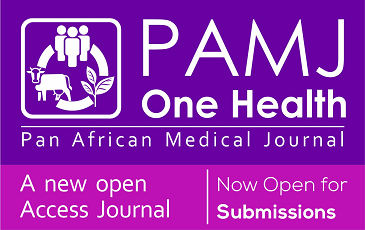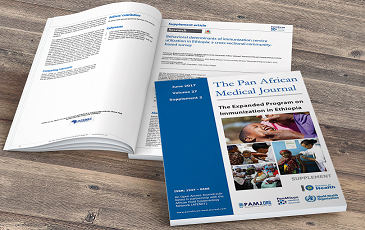Sacroiliitis indicative of sacroiliac tuberculosis in an immunocompetent adolescent: a case report
Rihanatou Prisca Toguyeni, Elsa Naomi Lydie Pikbougoum, Charles Sougué, Fulgence Kaboré, Wendlassida Joelle Stéphanie Zabsonré/Tiendrebeogo, Dieu-Donné Ouédraogo
Corresponding author: Rihanatou Prisca Toguyeni, Rheumatology Department, Bogodogo University Hospital, Ouagadougou, Burkina Faso 
Received: 03 Feb 2025 - Accepted: 01 Apr 2025 - Published: 16 Apr 2025
Domain: Infectious disease,Rheumatologist,Rheumatology
Keywords: Sacroiliitis, tuberculosis, Burkina, antituberculosis, case report
©Rihanatou Prisca Toguyeni et al. PAMJ Clinical Medicine (ISSN: 2707-2797). This is an Open Access article distributed under the terms of the Creative Commons Attribution International 4.0 License (https://creativecommons.org/licenses/by/4.0/), which permits unrestricted use, distribution, and reproduction in any medium, provided the original work is properly cited.
Cite this article: Rihanatou Prisca Toguyeni et al. Sacroiliitis indicative of sacroiliac tuberculosis in an immunocompetent adolescent: a case report. PAMJ Clinical Medicine. 2025;17:35. [doi: 10.11604/pamj-cm.2025.17.35.46756]
Available online at: https://www.clinical-medicine.panafrican-med-journal.com//content/article/17/35/full
Case report 
Sacroiliitis indicative of sacroiliac tuberculosis in an immunocompetent adolescent: a case report
Sacroiliitis indicative of sacroiliac tuberculosis in an immunocompetent adolescent: a case report
Rihanatou Prisca Toguyeni1, Elsa Naomi Lydie Pikbougoum1, ![]() Charles Sougué2,
Charles Sougué2, ![]() Fulgence Kaboré1,3,
Fulgence Kaboré1,3, ![]() Wendlassida Joelle Stéphanie Zabsonré/Tiendrebeogo1,3,
Wendlassida Joelle Stéphanie Zabsonré/Tiendrebeogo1,3, ![]() Dieu-Donné Ouédraogo1,3
Dieu-Donné Ouédraogo1,3
&Corresponding author
Sacroiliac tuberculosis is a rare pathology, diagnosed late with a variety of poorly localized symptoms. We report a case of tuberculous sacroiliitis in a 16-year-old immunocompetent patient. He consulted in the rheumatology department of the Bogodogo University Hospital first for acute inflammatory gluteal pain and then for low back pain. Computed Tomography (CT) scan and magnetic resonance imaging of the pelvis revealed a lesion of the sacroiliac joint and an abscess of the ilio-psoas muscle. The definitive diagnosis was made after the bacteriological study of the puncture fluid of the abscess. Treatment was conservative based on anti-tuberculosis drugs and the course was favorable. The early diagnosis of tuberculous sacroiliitis remains a challenge for the rheumatologist and reduces the risk of complications in the patient.
Tuberculosis remains a public health problem and is one of the leading causes of morbidity and mortality worldwide, according to the WHO [1]. It is on the rise in developing countries due to the AIDS pandemic, as people living with HIV/AIDS are 16 times more likely to contract tuberculosis [1]. Pulmonary involvement is the most frequently reported, and osteoarticular localizations account for only 5% of all infections [2,3]. The spine is the most affected osteoarticular site, accounting for more than 50% of osteoarticular tuberculosis [2]. Involvement of the sacroiliac joint is rare, accounting for 10% of osteoarticular infections [3,4]. Certain factors, such as HIV infection, diabetes, and alcoholism, are associated with the occurrence of tuberculosis [1]. Tuberculous sacroiliitis is diagnosed late because of insidious and poorly localized painful symptoms, as well as the misuse of antibiotics, which bastardizes the picture [3]. We report a case of tuberculous sacroiliitis in a 16-year-old adolescent.
Patient information: this was a 16-year-old patient with a history of mechanical low back pain that had progressed for six months and had been self-medicated with paracetamol, non-steroidal anti-inflammatory drugs (diclofenac), and amoxicillin. He did not consume alcohol, tobacco, or narcotics. The patient is said to have stayed with his grandmother, who had been treated with pulmonary tuberculosis and declared cured two years before the onset of symptoms.
Clinical findings: he consulted in the rheumatology department for an acute, inflammatory, disabling febrile right buttock with a temperature oscillating between 39° and 40°. The inflammatory assessment showed a C reactive protein (CRP) at 170mg/l with white blood cells at 11,470 predominantly neutrophils at 9,700/mm3.
Computed tomography: (CT) scan of the pelvis showed right sacroiliac osteoarthritis associated with a highly inflammatory appearance of the adjacent soft tissues with an ipsilateral iliac abscess estimated at 26cc (Figure 1,Figure 2). Haemoglobin electrophoresis was AA, liver serology B and C, and HIV serology were negative. In view of the acute symptomatology, high biological markers, the diagnosis of infectious sacroiliitis with common germs was made, and the patient was put on antibiotics (amoxicillin + clavulanic acid and gentamicin) for six weeks with a good clinical and paraclinical course in the short term. The patient consults two months after stopping antibiotics for a disabling, inflammatory low back pain that is not deficient. The physical examination revealed a dodge lameness, a low lumbar palpatory spinalgia, and the maneuver of spreading-bringing together the sacroiliacs was very painful. Patrick's sign was positive on the right as well as the tripod sign. The search for the sign of Lasègue was impossible because of the pain. He had no fever. The rest of the examination was without particularities. Additional examinations showed leukocytes at 6570/mm3 with neutrophils at 4490/mm3, lymphocytes at 1150/mm3; the CRP: 112.6. The blood culture did not find any germs.
Timeline of current episode: hip ultrasound in August 2024, Magnetic resonance imaging (MRI) in September 2024, Xpert gene in October 2024, follow-up hip ultrasound in January 2025.
Diagnostic assessment: tuberculin intradermal reaction positive at 22 mm but not phlyctenular, procalcitonin at 0.05. Magnetic resonance imaging (MRI) of the pelvis noted right sacroiliitis with an abscess of the adjacent soft tissues as well as the psoas (Figure 3,Figure 4). The puncture of the psoas abscess found a purulent fluid (Figure 5) and the mycobacterium tuberculosis (MTB) gene Xpert of the pus objectified many mycobacteria tuberculosis. As part of the disease assessment, the gene Xpert of sputum noted mycobacterium tuberculosis.
Diagnosis: bifocal tuberculosis (sacroiliac and pulmonary).
Therapeutic intervention: anti-tuberculosis antibiotic therapy (isoniazid 5 mg/kg/day, rifampicin 10 mg/kg/day, pyrazinamide 30 mg/kg/day, ethambutol 20 mg/kg/day) for two months, then rifampicin and isoniazid at the same doses for 10 months and analgesics. He also benefited from a puncture to evacuate the abscess of the ilio-psoas muscle.
Follow-up and outcome of interventions: the short- and medium-term evolution (three months) was good, marked by pain improvement and normalization of biological parameters.
Patient perspective: the patient was concerned at the beginning of the post-hospitalization symptomatology n1 for his functional prognosis, but he was reassured later after the initiation of anti-tuberculosis treatment. His father expressed blessings to the nursing staff of the department.
Informed consent: we obtained consent from the patient's father.
Tuberculosis is one of the most common infections in the world, affecting more than 10 million people each year, according to the World Health Organization (WHO) [1]. It preferentially affects immunocompromised people or those living in endemic areas [1]. The hip is a deep joint and, therefore, an uncommon site of bone tuberculosis, with an incidence of 5 to 10% of all bone tuberculosis [3]. In addition, osteoarticular tuberculosis accounts for 2 to 5% of tuberculosis and 11 to 15% of extrapulmonary tuberculosis according to Lazrak et al. [2].
The symptomatology of tuberculous sacroiliitis is generally poorly localized, isolated, and insidious, with little disturbed paraclinical biological signs [3,5]. This can lead to a late diagnosis. Indeed, it is a rare pathology with various presentations, with a probability of being confused with other diseases of the spine [3]. Low back pain is the main symptom that leads patients to seek medical attention [2]. This was also the case for our patient, where the reason for the second hospitalization was inflammatory low back pain. In addition, Koch's bacillus sacroiliitis can be confused with other causes of low back pain, such as disc disease, spondyloarthritis, and pyogenic infections [3]. Secondary abscess of the psoas is rare in tuberculous sacroiliitis and is most commonly seen in vertebral tuberculosis [6]. The sedimentation rate and C-reactive protein are frankly high in the case of sacroiliitis with common germs [4], moreover, the intradermal reaction to tuberculin (IDRt) should be phlyctenular in countries with high endemicity due to permanent contact with Koch's bacillus [4]. All this contributed to the delay in the diagnosis of our patient, who was initially treated as pyogenic sacroiliitis. Indeed, given his IDRt, which was 22 mm non-phlyctenular, his high biological parameters, and the acute nature of the hip pain [7] at his first hospitalization, we thought it was an infection with a common germ.
Kim et al. classified 4 types based on the clinical and radiographic severity of tuberculous sacroiliitis [8]. This classification helps in the choice of treatment, between conservative treatment using antibiotics and surgical treatment. According to them, types 1 and 2 can be treated with anti-TB alone, while types 3 and 4 will likely require surgery [8]. However, Kim et al. recommend surgical drainage to prevent recurrences, improve the effectiveness of anti-tuberculosis drugs, and thus reduce the total duration of treatment [8]. Another indication for surgery may be the persistence or progression of an abscess despite anti-TB drugs [3]. As for Zhu et al. they proposed a classification based on the surgical method and radiological characteristics into 3 types [9]. The authors suggest as treatment, in addition to anti-tuberculosis drugs, bed rest, immobilization in a cast or corset, and vitamin D supplementation [3]. In addition, the total duration of optimal treatment of the anti-TB drug varies between 9 and 24 months between the study and the study [3]. In our context, the treatment lasts 12 months, this is also the case for Lazrak et al. In our case we have chosen conservative treatment, as has been the case with some authors [6]. Our patient is a 17-year-old adolescent, while in the literature it was adult patients [2,4,6,10]. Multifocal TB can affect both immunocompromised and immunocompetent individuals [6].
Tuberculosis of the sacroiliac joint is an uncommon condition that is difficult and delayed diagnosing. It is important to emphasize the importance of examining the hips and thinking about tuberculosis sacroiliitis in the presence of any low back pain or gluteal pain or chronic radiculalgia in a patient with contributing factors or living in an endemic area. The interest of our case lies in the rarity of the pathology and in the therapeutic management, which must be early to avoid complications.
The authors declare no competing interests.
Patient management: Rihanatou Prisca Toguyeni and Elsa Naomi Lydie Pikbougoum. Data collection: Rihanatou Prisca Toguyeni and Elsa Naomi Lydie Pikbougoum. Manuscript drafting: Rihanatou Prisca Toguyeni. Manuscript revision: Charles Sougué and Fulgence Kaboré. Wendlassida Joelle Stéphanie Zabsonré/Tiendrebeogo and Dieu-Donné Ouédraogo contributed to the revision and supervision of the manuscript. All authors have read and approved the final version of this manuscript
Figure 1: computed tomography scan of the pelvis showing erosion of the right sacroiliac margins
Figure 2: injected computed tomography scan of the pelvis showing right sacroiliac osteoarthritis
Figure 3: T2 hypersignal of the right sacroiliac joint and soft tissue on magnetic resonance imaging of the pelvis
Figure 4: gadolinium enhancement of the right sacroiliac joint and adjacent soft tissue (magnetic resonance imaging)
Figure 5: purulent fluid from the psoas abscess
- World Health Organization. Tuberculosis . Accessed on Jan 16, 2025.
- Lazrak F, Abourazzak FE, Elouzzani FE, Benzagmout M, Harzy T. A rare location of sacral tuberculosis: A report of three cases. Eur J Rheumatol. 2014 Jun;1(2):78-80. PubMed | Google Scholar
- Jain VK, Iyengar KP, Botchu R, Vaishya R. Sacroiliac joint tuberculosis revisited - A clinico-radiological review.J Clin Orthop Trauma. 2021 Nov 16;24:101707. PubMed | Google Scholar
- Diallo I, Zabsonré JT, Kambou BMAT, Sondo AK, Sagna Y, Ouédraogo DD. Tuberculous sacroiliitis: about two cases. Pan Afr Med J. 2016;25:69. PubMed | Google Scholar
- Brasseur P, Koral E, Sukkarieh F, Vanhaeverbeek M, Bissen L. Sacro-iliite tuberculeuse: à propos d´un cas. Rev Med Brux. avr 2004;25(2):99-102. PubMed | Google Scholar
- Kramer L, Geib V, Evison J, Altpeter E, Basedow J, Brügger J. Tuberculous sacroiliitis with secondary psoas abscess in an older patient: a case report. Journal of Medical Case Reports. 18 août 2018;12(1):237. PubMed | Google Scholar
- Slobodin G, Rimar D, Boulman N, Kaly L, Rozenbaum M, Rosner I et al. Acute sacroiliitis. Clin Rheumatol. 1 avr 2016;35(4):851-6. PubMed | Google Scholar
- Kim NH, Lee HM, Yoo JD, Suh JS. Sacroiliac joint tuberculosis. Classification and treatment. Clin Orthop Relat Res. janv 1999;(358):215-22. PubMed | Google Scholar
- Zhu G, Jiang LY, Yi Z, Ping L, Duan CY, Yong C et al. Sacroiliac joint tuberculosis: surgical management by posterior open-window focal debridement and joint fusion. BMC Musculoskeletal Disorders. 29 nov 2017;18(1):504. PubMed | Google Scholar
- Miladi S, Ben Ayed H, Fazaa A, Sellami M, Ouenniche K, Souabni L et al. Common low back pain hiding tuberculous sacroiliitis. Clinical Case Reports. 2022;10(1):e05288. PubMed | Google Scholar









